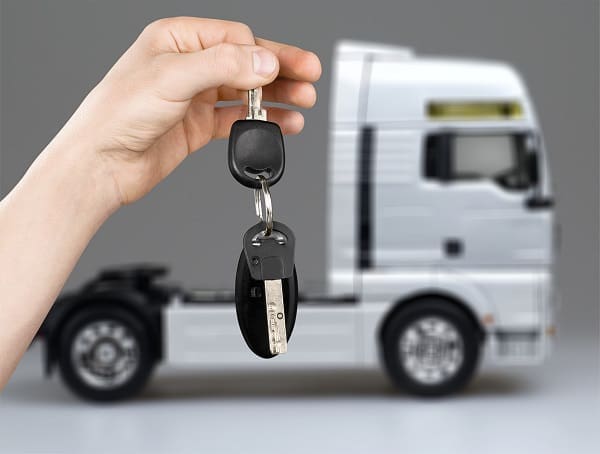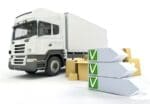
Is it better to lease vs. buy a car or commercial vehicle? People have been asking this question since leasing first became a viable option in the 1930s. Around a quarter of new vehicle financing, today is applied to leases, according to Experian. Yet, the answer isn’t quite so clear-cut and will differ depending on your current status and needs. We’ll give an overview of key differences, benefits, and drawbacks of leasing a car vs. buying below, so it’s easier to see what’s right for you.
What is the Difference Between Leasing and Buying a Car?
Both leasing and buying can provide you with a vehicle, but the agreements, terms, and fees are structured differently.
Car Leasing
Car leasing is usually similar to renting. We’ll go over the pros and cons in just a moment, but let’s start with a crash course in leasing terminology since it’s different from what most are accustomed to.
- Residual Value: Vehicles lose value over time and as wear and tear occur. Residual value refers to the vehicle’s value at the end of the lease. The shorter the lease, the greater the residual value is.
- Term Length: A lease is similar to a term length with a loan. It’s the total length of the agreement or the amount of time you’ll make payments. Short-term options are generally more expensive because the residual value decreases fastest during the first 24 months.
- Estimated Annual Mileage: Depending on your lease type, you may be asked to estimate how many miles you intend to drive annually.
- Capitalized Cost: Also referred to as “cap cost,” the capitalized cost is the price of the vehicle. The cap cost is usually fixed when the manufacturer sponsors the lease, though it can be negotiated in other cases.
- Cap Cost Reduction: Any discounts, such as lease deals from the automaker, are referred to as a cap cost reduction.
- Money Factor: Rather than calculate with interest rates, leases use a “money factor.” To calculate your APR, multiply your money factor by 2,400.
- Closed-End Lease: “Closed-end” leases are what most people think of when they hear the term “lease.” With these agreements, all the numbers are calculated in advance. As long as the vehicle is returned in the condition expected, when it’s expected, and with the anticipated mileage, it tends to be a very predictable process. The lessee doesn’t assume depreciation risk when the term ends.
- Open-End Lease: An open-end lease is more flexible. However, the lessee accepts more risk in an open-end lease because they agree to pay the difference between the estimated residual value and actual resale value at the end of the lease. Most businesses opt for an open-end lease over a closed-end lease because they tend to rack up miles, and it’s often less expensive to pay a difference in value than it is to pay a fee for mileage overages.
Buying a Vehicle
When most people talk about buying a car or commercial vehicle, they’re not generally talking about purchasing it with cash. Instead, they’re talking about taking out an auto loan to cover the cost. Nearly nine in ten adults have done just this, according to The Zebra, so we won’t go over this in too much depth.
When you finance a vehicle, you own it outright once your final lease payment is made. So while fees and interest are tacked onto the loan, you’re probably accustomed to the structure and terms offered.
What Are the Advantages of Leasing a Vehicle?
There are many benefits of choosing a lease vs. finance, whether you’re searching for business or personal use.
Lower Monthly Payments
You’ll almost always have lower monthly payments if you’re leasing. A typical lease is $506 per month, and a vehicle loan is $617, according to Experian research.
Free Up Cash Flow for Your Business (if Leasing a Company Car)
Experian’s figures are largely based on consumer shopping. As a business owner, you’ll likely have considerably more cash to put toward expenses and growth each month if you lease your business vehicles.
Latest Technology
Leases rose to fame because commercial enterprises needed to upgrade equipment every 12 months to have the latest tech.
Warranty Coverage and Maintenance
Most leases include all your maintenance and a warranty. That means lower expenses and fewer headaches for you.
It’s Easy to Trade Your Leased Vehicle In
By design, leases make it easy to trade the vehicle in at the end of your term.
Sales Tax Reduction
You have to pay sales tax on the full purchase price of a vehicle when you finance it. However, some jurisdictions only charge sales tax when you lease on the down payment and the contracted monthly payments.
Little or No Down Payment
Many leases don’t require a down payment or only have a small upfront cost. Although this can increase the monthly costs, it’s helpful for those shopping on a tight budget.
What Are the Disadvantages of Leasing a Vehicle?
Even though there are many advantages of leasing a vehicle, there are some disadvantages too. Let’s take a look.
You Don’t Own the Vehicle
Although some leases give you the option to purchase the vehicle at the end of the term, it’s not the norm. Instead, you have to give the vehicle back when your agreement ends.
You Always Have a Car Payment
When you take out an auto loan, you only make payments until the vehicle is paid off. Once you’re done, you’re done. Because leases aren’t intended to pay off a vehicle, you’ll always be making payments.
There’s a Mileage Limit
Estimated annual mileage can be a killer for people and businesses that drive a lot.
You Won’t Have Cash for Your Next Car
If you keep making payments on an auto loan, your vehicle will be worth more than you owe at some point. Known as “trade-in value,” this can help you put a serious dent in the amount you need to borrow for your next vehicle. With a lease, you don’t own the vehicle, so you can’t put your investment toward your next purchase.
Unexpected Lease-End Costs
Excess mileage charges can be hard to swallow. Sometimes leasing companies nickel and dime you for excessive wear and tear too.
Usage Restrictions
Again, you don’t own a car you’re leasing. That means the leasing company can stipulate you aren’t allowed to leave the country with the vehicle or may restrict you from using it in certain ways, such as operating as a Lyft or Uber driver.
You Need Gap Insurance
Gap insurance is insurance that pays off the balance of the vehicle in the event it’s declared a total loss or stolen. Some lenders require this with traditional auto loans because it protects their investment. Especially in the first 24 months, you owe more than the car is worth. Virtually all leasing companies require gap insurance for the same reason.
Leasing Can Be Difficult, Especially if You Have Bad Credit
Subprime borrowers, or those with a FICO Score below 670, only account for around 13 percent of vehicle lease balances, according to Equifax. While it’s technically possible to qualify for a lease with bad credit, the terms offered will not be great.
Lease Deals Are Limited
More often than not, leases are only offered to shoppers with excellent credit, though sometimes automakers will make additional lease options available when sales are lagging.
You Can’t Get Repairs Done Anywhere
Even though maintenance is covered, you’re at the mercy of the leasing company’s network for all maintenance and repairs. Unfortunately, that usually means returning to the dealership for repairs, typically increasing costs for non-covered items.
You Have to Return the Car in Great Shape
Generally speaking, leasing companies use the “credit card test.” If a scratch or scuff is smaller than a credit card, you’ll get a pass on the damage when the lease ends. However, this doesn’t necessarily extend to glass and interiors, and it’s not a hard rule. If the vehicle is returned with any damage, wear, or tear that the leasing company deems is not normal for the period of time you’ve had the vehicle, you’ll get hit with additional fees.
It’s a Binding Contract
Even though leases only last a short time, the consequences of violating your agreement can stick with you and on your credit report for years to come.
What Are the Benefits of Buying a Vehicle?
Now that we’ve covered the benefits and drawbacks of leasing a car vs. buying let’s take a look at it from the buying side.
You Own the Vehicle
Whether you purchase it outright or make payments, once the vehicle is paid in full, it’s yours to do with as you wish.
You Are Creating an Asset for Your Balance Sheet
Any value in a vehicle you’ve purchased is yours. It counts as a personal or business asset, which means you can use it to demonstrate financial strength or as collateral on a loan.
Your Business Can Claim Depreciation on Taxes
If you are weighing the pros and cons to decide whether you should buy or lease a car for your business, tax benefits are an important consideration. Because you own the asset, you can also claim any depreciation on your taxes. Combined, businesses can claim over $1 million on equipment, according to IRS Section 179.
Where, When, And How far You Drive Are Your Choices
As long as it’s legal, you can take a vehicle you own anywhere you wish, whether it’s next door, Mexico, or Canada.
You Can Get Cash to Pay for Your Next Car
The equity in your vehicle is yours, so you can roll it into your next vehicle if you wish.
You Can Customize Your Vehicle However You Choose
Vehicles earmarked for leases are cookie-cutter cars. If you want any kind of upgrades or custom accessories, purchasing a vehicle is the way to go.
Once Your Loan is Paid Off, There Are No More Payments
Whereas you’re tied into payments as long as you’re leasing, you don’t have payments once your vehicle is paid off if you buy it.
You Can Sell on Your Own Schedule
Whether you want to trade your vehicle in after six months or 12 years, it’s totally up to you when you buy.
Financing for a Purchase Is Easier Than Leasing
There’s less risk for funding companies when they’re selling a vehicle than leasing one, so they can typically work with individuals and businesses with light credit files or bad credit.
Refinancing Can Save You Money Down the Road
When you lease, your monthly payment is your monthly payment for as long as the term lasts. However, if interest rates drop after you buy or you do major credit repair/ building, you can refinance to get better terms and save money.
What Are the Disadvantages of Buying?
Even though buying a vehicle has many advantages, there are some challenges or drawbacks associated with purchasing too.
Buying a Car is More Expensive in the Short Term
Your monthly payments will generally be higher if you’re purchasing. Expect to make a down payment too.
You Pay Interest on the Entire Cost of the Car
True, leasing uses a money factor instead of interest, but the general concept applies – you’re only paying toward what you owe. With a loan, you’re paying interest on the full amount borrowed instead of a portion of the vehicle.
You May Have to Pay More Sales Tax
While you can escape some sales tax in certain jurisdictions, you’re on the hook for the full amount when you purchase.
The Car’s Future Value Is Unknown
Compared to a closed-end lease, purchasing a vehicle is riskier. You take the hit if the vehicle depreciates dramatically.
The Warranty Will End
Vehicle warranties only last a couple of years. Once the warranty ends, you’re responsible for handling all repairs.
Lease vs. Buy a Car: The Main Things to Consider
Now that we’ve covered all the benefits and drawbacks, what really matters when deciding whether to lease vs. buy a car?
How Much Does it Really Cost on a Monthly Basis?
- Monthly Payments: Consider your full monthly payment to the leasing company or lender.
- Car Insurance: Leasing companies often require lessees to maintain high coverage levels. If you wouldn’t normally maintain high tiers, leasing can increase your monthly payments overall.
What Are the Overall Costs?
- Down Payment: Leases generally require a lower down payment than loans.
- Interest: Your APR will usually be higher with a lease.
- Repairs: Repairs are yours to cover when you purchase.
- Depreciation: You take the depreciation hit with a purchase and may be unexpectedly saddled with additional depreciation-related fees with some leases.
- Leasing Fees: Each leasing company charges different fees. Make sure you understand all your charges before signing an agreement.
Flexibility
Purchasing an open-ended lease is probably better if you crave flexibility, but remember that you’re assuming more risk with these options.
Mileage for Businesses that Do Long Distances
If you plan to drive a lot, purchasing the vehicle may be more cost-effective, or opt for an open-ended lease.
Owning vs. Leasing a Car: Which is Right for You?
The lease vs. buying a car debate has no wrong or right. It’s a matter of choosing what’s right for you or your business. Use the information outlined here to make an informed decision that will serve you well today and in the coming years.
Charter Capital Can Help Whether You Want to Own or Lease
Are slow-paying clients standing between you and the vehicle you need to expand your business? Maybe you’d like a down payment, want to bridge a cash flow gap without taking on debt, or want to take on more work but don’t have the working capital to cover the expense? Charter Capital can help by unlocking the cash trapped in your unpaid B2B invoices through invoice factoring. Contact us for a complimentary quote.
Is buying a car better than leasing?
The lease vs. buying a car debate has no wrong or right. It’s a matter of choosing what’s right for you or your business. Use the information outlined here to make an informed decision.
Is it financially smart to lease a car?
When you take out an auto loan, you only make payments until the vehicle is paid off. Once you’re done, you’re done. Because leases aren’t intended to pay off a vehicle, you’ll always be making payments.
What are the disadvantages of leasing a car?
Disadvantages of Leasing a Vehicle:
• You don’t own the vehicle
• You always have a car payment
• There’s a mileage limit
• You won’t have cash for your next car
• There are usage restrictions
• You need gap insurance
• Lease deals are limited
• You can’t get repairs done anywhere
• You have to return the car in great shape






